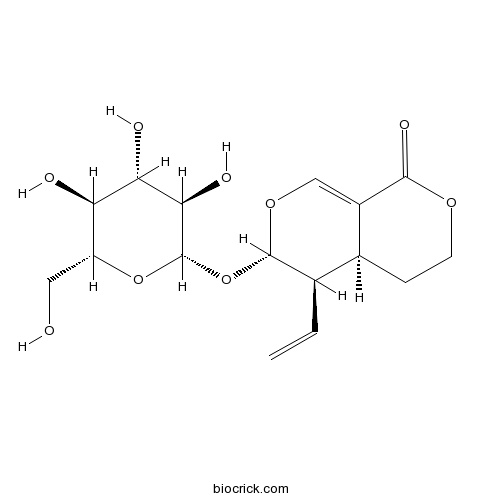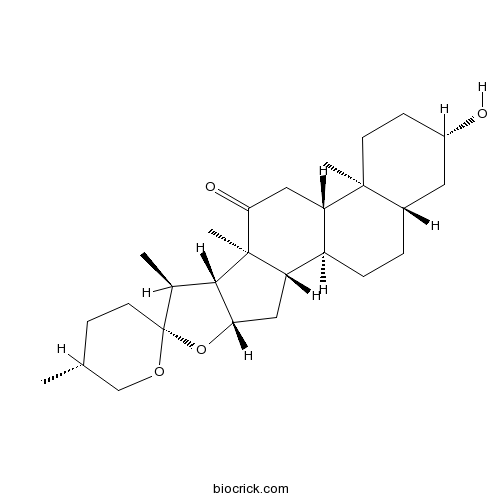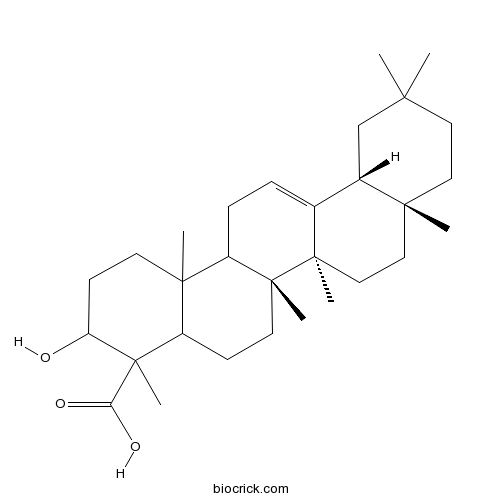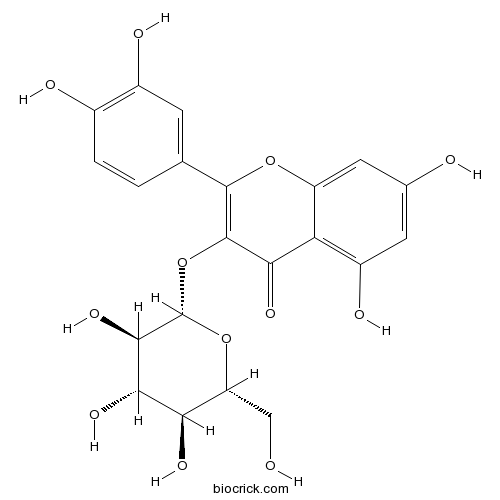Hemerocallis fulva
Hemerocallis fulva
1. The products in our compound library are selected from thousands of unique natural products; 2. It has the characteristics of diverse structure, diverse sources and wide coverage of activities; 3. Provide information on the activity of products from major journals, patents and research reports around the world, providing theoretical direction and research basis for further research and screening; 4. Free combination according to the type, source, target and disease of natural product; 5. The compound powder is placed in a covered tube and then discharged into a 10 x 10 cryostat; 6. Transport in ice pack or dry ice pack. Please store it at -20 °C as soon as possible after receiving the product, and use it as soon as possible after opening.
Natural products/compounds from Hemerocallis fulva
- Cat.No. Product Name CAS Number COA
-
BCN6219
Sweroside14215-86-2
Instructions

-
BCN5408
Hecogenin467-55-0
Instructions

-
BCN5522
alpha-Boswellic acid471-66-9
Instructions

-
BCN5569
Isoquercitrin482-35-9
Instructions

-
BCN5570
Hyperoside482-36-0
Instructions

Aqueous and Ethanol Extracts of Daylily Flower (Hemerocallis fulva L.) Protect HUVE Cells Against High Glucose.[Pubmed: 29693723]
None
[Effects of inter-row economic crop planting on soil moisture in a rain-fed jujube orchard in loess hilly region, China].[Pubmed: 27396124]
Soil moisture variation in dryland sloping jujube. orchard was investigated after introducing two economic crops, i.e., feed Brassica napus (JR) and Hemerocallis fulva (JH) planted between jujube rows. Jujube tree without inter-row crop was set as control (CK). The results showed that mean soil moisture for JR and JH in the 0-180 cm soil layer increased by 6.2% and 10.1% compared with CK, respectively. Soil moisture changed mainly in the 0-60 cm soil layer in growth stage of Jujube trees. Soil moisture in JR and JH treatments significantly increased in the 0-60 cm soil layer, which could meet the demand in water resource of jujube plantation. The water consumption of jujube trees also mainly concentrated in the 0-60 cm soil layer. There was a significant decay exponential relationship between the soil moisture in the 0-20 cm layer and the drought duration after rainfall. During the 18-day dry period after rain, the soil moisture contents of JR and JH were apparently higher than that of CK. In conclusion, the jujube-crop intercropping system improved the soil moisture condition. It was an effective measure to overcome the seasonal drought in jujube orchards on the loess hilly region.
Sequence analysis and genetic diversity of five new Indian isolates of cucumber mosaic virus.[Pubmed: 26666188]
Cucumber mosaic virus (CMV) is an important virus since it causes severe losses to many economically important crops worldwide. Five new isolates of CMV were isolated from naturally infected Hippeastrum hybridum, Dahlia pinnata, Hemerocallis fulva, Acorus calamus and Typhonium trilobatum plants, all exhibiting severe leaf mosaic symptoms. For molecular identification and sequence analyses, the complete coat protein (CP) gene of these isolates was amplified by RT-PCR. The resulting amplicons were cloned and sequenced and isolates were designated as HH (KP698590), DP (JF682239), HF (KP698589), AC (KP698588) and TT (JX570732). For study of genetic diversity among these isolates, the sequence data were analysed by BLASTn, multiple alignment and generating phylogenetic trees along with the respective sequences of other CMV isolates available in GenBank Database were done. The isolates under study showed 82-99% sequence diversity among them at nucleotide and amino acid levels; however they showed close relationships with CMV isolates of subgroup IB. In alignment analysis of amino acid sequences of HH and AC isolates, we have found fifteen and twelve unique substitutions, compared to HF, DP and TT isolates, suggesting the cause of high genetic diversity.
Paenibacillus oenotherae sp. nov. and Paenibacillus hemerocallicola sp. nov., isolated from the roots of herbaceous plants.[Pubmed: 25977281]
Two Gram-staining-positive, aerobic, endospore-forming, motile bacteria, strains DT7-4T and DLE-12T, were isolated from roots of evening primrose (Oenothera biennis) and day lily (Hemerocallis fulva), respectively, and subjected to taxonomic characterization. Analysis of 16S rRNA gene sequences indicated that the two strains fell into two distinct phylogenetic clusters belonging to the genus Paenibacillus. Strain DT7-4T was most closely related to Paenibacillus phyllosphaerae PALXIL04T and Paenibacillus taihuensis THMBG22T, with 96.3% 16S rRNA gene sequence similarity to each, and strain DLE-12T was most closely related to Paenibacillus ginsengarvi Gsoil 139T and Paenibacillus hodogayensis SGT, with 96.6 and 93.3% sequence similarity, respectively. Both isolates contained anteiso-C15 : 0 as the dominant fatty acid, meso-diaminopimelic acid as the diagnostic diamino acid in the cell-wall peptidoglycan and MK-7 as the respiratory menaquinone. The cellular polar lipids were composed of diphosphatidylglycerol, phosphatidylethanolamine, phosphatidylglycerol and unidentified polar lipids. The DNA G+C contents of strains DT7-4T and DLE-12T were 50.1 ± 0.7 and 55.2 ± 0.5 mol%, respectively. The chemotaxonomic properties of both isolates were typical of members of the genus Paenibacillus. However, our biochemical and phylogenetic analyses distinguished each isolate from related species. Based on our polyphasic taxonomic analysis, strains DT7-4T and DLE-12T should be recognized as representatives of novel species of Paenibacillus, for which the names Paenibacillus oenotherae sp. nov. (type strain DT7-4T = KCTC 33186T = JCM 19573T) and Paenibacillus hemerocallicola sp. nov. (type strain DLE-12T = KCTC 33185T = JCM 19572T) are proposed.
Barcoding melting curve analysis for rapid, sensitive, and discriminating authentication of saffron (Crocus sativus L.) from its adulterants.[Pubmed: 25548775]
Saffron (Crocus sativus L.) is one of the most important and expensive medicinal spice products in the world. Because of its high market value and premium price, saffron is often adulterated through the incorporation of other materials, such as Carthamus tinctorius L. and Calendula officinalis L. flowers, Hemerocallis L. petals, Daucus carota L. fleshy root, Curcuma longa L. rhizomes, Zea may L., and Nelumbo nucifera Gaertn. stigmas. To develop a straightforward, nonsequencing method for rapid, sensitive, and discriminating detection of these adulterants in traded saffron, we report here the application of a barcoding melting curve analysis method (Bar-MCA) that uses the universal chloroplast plant DNA barcoding region trnH-psbA to identify adulterants. When amplified at DNA concentrations and annealing temperatures optimized for the curve analysis, peaks were formed at specific locations for saffron (81.92°C) and the adulterants: D. carota (81.60°C), C. tinctorius (80.10°C), C. officinalis (79.92°C), Dendranthema morifolium (Ramat.) Tzvel. (79.62°C), N. nucifera (80.58°C), Hemerocallis fulva (L.) L. (84.78°C), and Z. mays (84.33°C). The constructed melting curves for saffron and its adulterants have significantly different peak locations or shapes. In conclusion, Bar-MCA could be a faster and more cost-effective method to authenticate saffron and detect its adulterants.
Fungal Planet description sheets: 214-280.[Pubmed: 25264390]
Novel species of microfungi described in the present study include the following from South Africa: Cercosporella dolichandrae from Dolichandra unguiscati, Seiridium podocarpi from Podocarpus latifolius, Pseudocercospora parapseudarthriae from Pseudarthria hookeri, Neodevriesia coryneliae from Corynelia uberata on leaves of Afrocarpus falcatus, Ramichloridium eucleae from Euclea undulata and Stachybotrys aloeticola from Aloe sp. (South Africa), as novel member of the Stachybotriaceae fam. nov. Several species were also described from Zambia, and these include Chaetomella zambiensis on unknown Fabaceae, Schizoparme pseudogranati from Terminalia stuhlmannii, Diaporthe isoberliniae from Isoberlinia angolensis, Peyronellaea combreti from Combretum mossambiciensis, Zasmidium rothmanniae and Phaeococcomyces rothmanniae from Rothmannia engleriana, Diaporthe vangueriae from Vangueria infausta and Diaporthe parapterocarpi from Pterocarpus brenanii. Novel species from the Netherlands include: Stagonospora trichophoricola, Keissleriella trichophoricola and Dinemasporium trichophoricola from Trichophorum cespitosum, Phaeosphaeria poae, Keissleriella poagena, Phaeosphaeria poagena, Parastagonospora poagena and Pyrenochaetopsis poae from Poa sp., Septoriella oudemansii from Phragmites australis and Dendryphion europaeum from Hedera helix (Germany) and Heracleum sphondylium (the Netherlands). Novel species from Australia include: Anungitea eucalyptorum from Eucalyptus leaf litter, Beltraniopsis neolitseae and Acrodontium neolitseae from Neolitsea australiensis, Beltraniella endiandrae from Endiandra introrsa, Phaeophleospora parsoniae from Parsonia straminea, Penicillifer martinii from Cynodon dactylon, Ochroconis macrozamiae from Macrozamia leaf litter, Triposporium cycadicola, Circinotrichum cycadis, Cladosporium cycadicola and Acrocalymma cycadis from Cycas spp. Furthermore, Vermiculariopsiella dichapetali is described from Dichapetalum rhodesicum (Botswana), Ophiognomonia acadiensis from Picea rubens (Canada), Setophoma vernoniae from Vernonia polyanthes and Penicillium restingae from soil (Brazil), Pseudolachnella guaviyunis from Myrcianthes pungens (Uruguay) and Pseudocercospora neriicola from Nerium oleander (Italy). Novelties from Spain include: Dendryphiella eucalyptorum from Eucalyptus globulus, Conioscypha minutispora from dead wood, Diplogelasinospora moalensis and Pseudoneurospora canariensis from soil and Inocybe lanatopurpurea from reforested woodland of Pinus spp. Novelties from France include: Kellermania triseptata from Agave angustifolia, Zetiasplozna acaciae from Acacia melanoxylon, Pyrenochaeta pinicola from Pinus sp. and Pseudonectria rusci from Ruscus aculeatus. New species from China include: Dematiocladium celtidicola from Celtis bungeana, Beltrania pseudorhombica, Chaetopsina beijingensis and Toxicocladosporium pini from Pinus spp. and Setophaeosphaeria badalingensis from Hemerocallis fulva. Novel genera of Ascomycetes include Alfaria from Cyperus esculentus (Spain), Rinaldiella from a contaminated human lesion (Georgia), Hyalocladosporiella from Tectona grandis (Brazil), Pseudoacremonium from Saccharum spontaneum and Melnikomyces from leaf litter (Vietnam), Annellosympodiella from Juniperus procera (Ethiopia), Neoceratosperma from Eucalyptus leaves (Thailand), Ramopenidiella from Cycas calcicola (Australia), Cephalotrichiella from air in the Netherlands, Neocamarosporium from Mesembryanthemum sp. and Acervuloseptoria from Ziziphus mucronata (South Africa) and Setophaeosphaeria from Hemerocallis fulva (China). Several novel combinations are also introduced, namely for Phaeosphaeria setosa as Setophaeosphaeria setosa, Phoma heteroderae as Peyronellaea heteroderae and Phyllosticta maydis as Peyronellaea maydis. Morphological and culture characteristics along with ITS DNA barcodes are provided for all taxa.
Construction and significance analysis of the MicroRNA expression profile of Hemerocallis fulva at low temperature.[Pubmed: 25036823]
MicroRNA (miRNA) identification was performed in Hemerocallis fulva by high-throughput sequencing in combination with bioinformatics prediction. A total of 14,843,184 and 16,072,575 RNA sequences were explored under normal and low temperature conditions, respectively. There was a significant difference in RNAs species and quantity between the two samples. Of all the miRNAs, 26 were significantly upregulated and 30 were significantly downregulated, while nine were either significantly upregulated or downregulated under low-temperature stress. Twenty-one highly expressed miRNA families were screened in at least six species. The number of miRNA families was very similar between monocotyledons and dicotyledons, and only a few were more frequently found in monocotyledons.
Antioxidant activity in extracts of 27 indigenous Taiwanese vegetables.[Pubmed: 24858497]
The objectives of this study were to identify the antioxidants and antioxidant axtivity in 27 of Taiwan's indigenous vegetables. Lycium chinense (Lc), Lactuca indica (Li), and Perilla ocymoides (Po) contained abundant quercetin (Que), while Artemisia lactiflora (Al) and Gynura bicolor (Gb) were rich in morin and kaempferol, respectively. Additionally, Nymphoides cristata (Nc) and Sechium edule (Se)-yellow had significantly higher levels of myricetin (Myr) than other tested samples. Cyanidin (Cyan) and malvidin (Mal) were abundant in Gb, Abelmoschus esculentus Moench (Abe), Po, Anisogonium esculentum (Retz.) Presl (Ane), Ipomoea batatas (Ib)-purple, and Hemerocallis fulva (Hf)-bright orange. Relatively high levels of Trolox equivalent antioxidant capacity (TEAC), oxygen radical absorption capacity (ORAC), and 1,1-diphenyl-2-picryl-hydrazyl (DPPH) radical scavenger were generated from extracts of Toona sinensis (Ts) and Po. Significant and positive correlations between antioxidant activity and polyphenols, anthocyanidins, Que, Myr, and morin were observed, indicating that these phytochemicals were some of the main components responsible for the antioxidant activity of tested plants. The much higher antioxidant activity of Po, Ts, and Ib (purple leaf) may be related to their higher Cyan, Que, and polyphenol content.
An evaluation of novel biological activity in a crude extract from Hemerocallis fulva L. var. sempervirens M. Hotta.[Pubmed: 24854051]
Hemerocallis fulva L. var. sempervirens M. Hotta (kwanso) represents an exceptional resource for identifying and developing new phytomedicines for the treatment and prevention of disease. The aim of this study was to conduct a detailed investigation of the biological activities of kwanso. Our study resulted in four major findings. First, kwanso scavenges hydroxyl radicals generated by H(2)O(2)/UV light system in vitro in a dose-dependent manner. Second, hepatic glutathione levels were significantly increased when kwanso was orally administered to mice. Third, the oral administration of kwanso to mice showed a tendency to suppress hepatic injury induced by acetaminophen. Finally, kwanso slightly inhibited cytochrome P450 3A activity. These results provide useful evidence in support of the development of kwanso as a candidate raw material for the treatment and prevention of disease.


